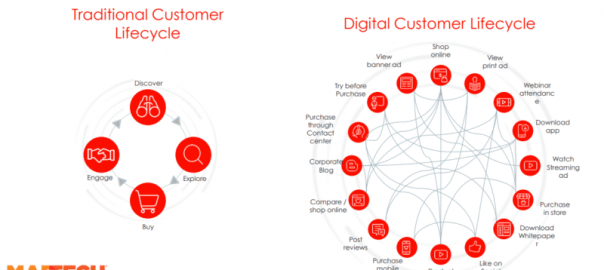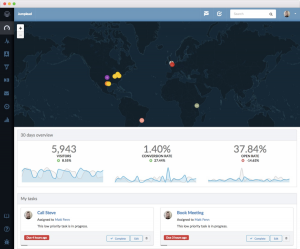And how to do it: Responding to your customers’ needs is critical for a cross-channel marketing strategy.
“Brands struggle with where to start,” said Ben Tepfer, Senior Technical Evangelist at Adobe, talking about customer journey orchestration at our recent MarTech conference. “There’s new channels, there’s new social networks. There’s old mediums that are no longer of as much use. So as marketers, we need to be thinking constantly about, what are the channels today and what are the channels going to look like in the future?”
That’s especially the case at a point in time where the pandemic and a range of social upheavals have been driving new consumer behavior in an ever-widening variety of channels.
Customers demand for personalized messaging
When customers see your brand, they expect a consistent message, no matter what channel they’re on. And if they come to you with a problem or a question on one channel, they expect the conversation to flow seamlessly to other digital outposts.

That’s because customers value the products and services that they buy from your brand. But they also loop experience in as part of that value, according to Tepfer. Customers like brands to know who they are.
“Customers demand experiences that are consistent and personalized across every one of these channels,” he said. “If they’re reaching out to you via chatbot for customer service, or walking into a store, they’re expecting that [consistency of experience]. Consumers expect that you’re going to talk to them and treat them the exact same way, and so that’s why orchestrating journeys is so important.”
Orchestration provides a competitive edge
Orchestrating a customer journey can be an opportunity for your brand to gain a competitive edge and disrupt your category.
“The status quo is absolutely not a best business practice,” said Tepfer. “So, think about how you can disrupt your market and let your customers be in charge of their journeys.”
He added, “The idea of the customer journey is really a combination of both intelligence from marketing systems but also orchestration as well as all of you and your teams, because it’s you who generate those experiences.”
Tepfer suggests that marketers begin by taking small steps that build out an experience. As more channels and technology are added to your strategy, the experience will grow.
“You can then start thinking about what are the different cross-channel opportunities that I have,” he explained.
The more data you have, the better informed your responses will be.
Just because the customer expects consistency doesn’t mean that communication on every channel is the same. That’s why data helps to inform the right message or action.
For instance, one of your e-commerce customers has left some items in their cart. In this case, a push notification about abandoned items could be appropriate.
The more interactions you have with a customer, the better data there is to inform that action. You can begin to tailor messaging and cadence according to their buying history.
“For somebody who is maybe a high value customer who has a high tendency to make purchases, we want to give them a certain journey,” said Tepfer. “Whereas, others we want to personalize a little bit more generically, and so we can use this data around the customer to personalize what that journey looks like so that we do end up looking at different branches of the journey and always personalizing based on the customer’s interactions and expectations.”
3 key ingredients of orchestration
“The concept of building a journey is in some ways quite like building a five-star meal,” said Tepfer. “You need a few key things that will make you an expert marketing chef.”
Foundation. Marketers need to have data as the foundation of this journey they’re taking with their customers. They need to also be able to understand the data and view it centrally. Marketing teams, as well as sales, customer service and other teams, must also have this same central view.
“You need a view of the customer that’s actually tied across sales, service, support, etc, because then you can be really personalizing the journey,” said Tepfer. “And the journey isn’t always what we expected.”
To help get the most out of this data, the marketing team also needs the technology and people to help build on this foundation.
“You need technology that acts and listens in real-time that follows through with customer engagements and behaves in a way that lets customers drive their own conversations,” Tepfer said.
Listening and responding. Once you have the foundation in place, you’re set up to communicate in a more responsive way to your customers. No matter what channel the customer is on, make sure that you are listening and responding in kind.
“You should be constantly reflecting on what your customer is looking for,” said Tepfer. “If you are sending them too many emails, send them a few less. If you can see they’re reacting to you better on the web, or on mobile, focus your energy there, because those better personalized moments are the ones that matter.”
This makes sure that your customer is on an actual journey, and not just receiving a disjointed one-off notification or email.
Providing value. Above all, with this data and attention in place, make sure that the interactions you have with customers on their journeys is of value to them, as well as to your marketing team.
“If you’re not delivering value, then you’re not succeeding,” said Tepfer. “What’s the best experience right now and what’s the best experience going to be down the road? It means responding at the right time and on the right channels.”
The customer is the one that is ultimately in the driver’s seat, wielding the power to decide whether to purchase or to go with a competitor. By orchestrating the journey, you can find the right place and time to send the most relevant messaging. If your communications are of value to the customer, they’ll take you along on their journey.
Snapshot: Customer journey analytics
Businesses know they need to be customer-focused in each aspect of their marketing operations. As a first step, brands need to understand how consumers are finding them. Whether it be via search, advertisement, or word of mouth, the medium used will set the trajectory for the rest of their journey.
Capturing their interactions post-discovery, such as communication with a call center or visit to a retail outlet, helps brands see which of their assets are helping them along their path. What’s more, brands need to know what those who convert do post-purchase–this information helps companies win repeat business and encourage customer advocacy.
These questions aren’t easily answered, but customer journey analytics tools do just that. Interest in these solutions has grown due to the increasing complexity of the customer journey, spurred on by the proliferation of devices and evolving consumer behavior and expectations.
The average person uses many devices to access the internet. Cisco forecasts that the number of devices connected to IP networks will increase to more than three times the global population by 2023. With so many devices, people shift back and forth depending on the task at hand and their current environment. Consumers and business buyers turn to an average of nine channels to browse product inventory, look for advice, and make purchases.
The post Why cross-channel customer journey orchestration is important appeared first on MarTech.
(16)
Report Post








